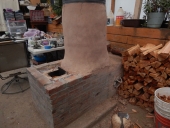posted 7 years ago
Some ideas:
1) wood ash (great insulator)
2) rice hulls
3) I think any shredded organic material like straw, sawdust, paper, leaves, grass, would leave an insulating void, even if it outgasses.
4) aerated refractory cement/concrete. Make a foaming solution (6 cups of water , 1 cup of dish soap, 1 tablespoon of glycerin or 1/4 cup of corn syrup). Wip it into a foam. Mix it into the cement/concrete. Or use a concrete mix with aluminum powder which reacts with lime to make hydrogen bubbles (the hydrogen later diffuses out of the set concrete and is replaced with air). Bits of this could be used as a substitute for perlite. This also makes an interesting building material.






